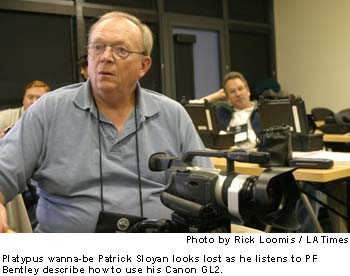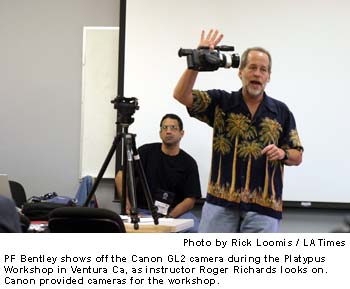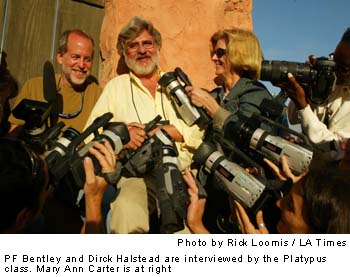| My Mother
Never
Imagined I would be a Platypus
August 2003
by Patrick J. Sloyan |

|
 Rolling
around on the tennis court for a low-angle shot, I realized that my
subject—the pro at the Pierpont Inn tennis club—was talking
but not into the headphoness attached to my Canon GL2. I sat up on the
court and slapped the earphones. Nothing. Rolling
around on the tennis court for a low-angle shot, I realized that my
subject—the pro at the Pierpont Inn tennis club—was talking
but not into the headphoness attached to my Canon GL2. I sat up on the
court and slapped the earphones. Nothing.
The tiny mike attached to the pro’s tennis shirt was not transmitting
sound to my awesome digital movie camera. What was worse was the realization
than my interview minutes earlier with the pro that would serve as the
voice over for stunning pictures of him in action was non-existent.
For, I had recorded him on the same mike that was clearly dysfunctional
on the tennis court.
Whether it was from rolling around in the sun or the pressure of the
Platypus Workshop Exercise No. 2, I was now dripping. There was only
two hours to produce an edited three-minute piece (or was it three hours
to produce a two-minute piece?) Suitable to network television. Time
was running out.
I was the only writer in a collection of men and women who were making
the transition from the increasingly difficult world of still news photography
to the limitless horizon of digital film journalism. Life is rough on
the cutting edge.
It got worse when I returned to the Brooks Institute of Photography
where the Platypus Workshop was held June 21-30. One of the senior instructors,
P.F. Bentley, ripped into me for not spotting the mike problem sooner.
I had failed to wear the camera headphone during the interview with
the tennis pro. They had been draped around my neck. “Put them
on your ears,” Bentley barked.
He rolled an elevated seat into the middle of the classroom, dimmed
the lights and showed my wandering footage. Instead of the remote mike
picking up the sound of the tennis pro, the camera ‘s built-in
microphone recorded my groans as I rolled about on the tennis court.
With every groan, my colleagues roared.
Dirck Halstead savaged the footage. Ostensibly, the piece would portray
the pro’s work with children. “Not one picture of the pro
handing a racquet to a kid,” Halstead said as I squirmed on the
hotseat. Humiliation is easier to handle when it is passed around to
your peers. Halstead and Bentley poured it on during those early exercises.
Bumbling along was Rick Loomis, who won National Photographer of the
Year for his Iraq coverage for the Los Angeles Times. Struggling was
Brian Van der Brug and Geraldine Wilkins, also Los Angeles Times staffers.
Meri Simon of the San Jose Mercury violated every bit of direction is
filming her voice-over interview; know in the film business as A Roll.
Mary Ann Carter of Indianapolis, Ind., and Mariella Furrer of Narobi,
Kenya—both freelancers—seemed unable to ask questions that
produced answers from filmed subjects.
Bit by bit, day by day, we all got better.
 The
humor of Bentley and reassurances by Halstead along with their coaching
and insights produced dramatic improvements. “I was once right
where you are now,” said Halstead, recalling his transition from
a Time magazine news photographer to a documentary filmmaker. “You
will get better.” The
humor of Bentley and reassurances by Halstead along with their coaching
and insights produced dramatic improvements. “I was once right
where you are now,” said Halstead, recalling his transition from
a Time magazine news photographer to a documentary filmmaker. “You
will get better.”
The careers of Halstead and Bentley, also
a Time veteran, provide a foundation for these workshops named after
the Australian animal that has survived for 110 million years by adapting
to a changing habitat. Both thrived on the riches of Time, Inc., for
decades when the magazine need color photographs to balance color advertising
during the printing process.
Once digitization and pagination took over at Time, the color ads could
be printed individually without need for balancing news photographs.
Suddenly, the princes of the photography staff were under the gun. Rather
than submit to a new contract and lower wages, Bentley and Halstead
walked away. Halstead now teaches at the University of Texas in Austin.
Bentley on the staff at Brooks.
Their careers were on display during evening sessions of the Workshop.
Halstead’s work of 40 years was contained in a 10-minute film
mainly of stills from Vietnam and Washington in brilliant color. Bentley’s
coverage of national political campaigns has that grainy black-and-white
quality that adds a dramatic dimension.
The lifestyles of Halstead and Bentley, the First Class airline seats,
the golden overtime, the bonuses and other benefits have evaporated
for most of the younger photojournalists. The New York Times, the Washington
Post and most every major news magazine have adopted pay and reproduction
policies, which have virtually squeezed out freelance photographers.
At Platypus, photojournalists learn to seize the very digital technology
that has so depressed their profession. Canon, Sony and other camera
makers are producing movie cameras for $2,500-$3500 that are on equal
footing with network and studio machines costing $30,000 or more. The
advent of digital film editing has turned the Powermac G4 and Final
Cut Pro 3 into a tool once found only at major studios. Step by step,
each student learns how to plan a film; use lighting and tripods; plan
and execute A Roll interviews; scramble for B Roll footage that is the
heart of the film; write a script and edit. Each person becomes an entire
camera crew—producer, cameraman, soundman, and editor.
 One goal: plan and complete a documentary that will be purchased by
ABC Nightline. Halstead, Bentley and past Workshop graduates have become
Nightline contributors.
One goal: plan and complete a documentary that will be purchased by
ABC Nightline. Halstead, Bentley and past Workshop graduates have become
Nightline contributors.
Halstead and Bentley look past Nightline when cable news and drama shows
will be hungry for the work of frontline journalists who can handle
movie film and well as stills. Future demand maybe endless. “Good
TV is what we are shooting for,” said Bentley. “There is
a beginning, a middle and an end. Keep it focused.”
Proof that Platypus produces could be seen in the final exercise: A
five-minute project that required pre-approval by the staff and a script.
Of course there is always a ringer in these events. Bryan Chan, a staffer
with the Los Angeles Times, has worked with his own Canon GL2 and editing
setup before coming to Ventura. His work was almost professional from
start to finish, including a noisy stone sculptor and a Ventura city
worker in charge of cleaning graffiti off of town walls.
More surprising was Alan Lessig, a photographer for the Army Times in
Washington, D.C. Lessig’s initial footage of a teenager at a skateboard
park was somewhere between dopey and insipid. But his final edit was
a dazzling display of entertaining gyrations. “You’ve made
a silk purse out of a sow’s ear,” said Halstead.
My personal favorite was Brian Van der Brug’s backcountry blacksmith
with sounds and close-ups that evoked the art and the smells of a bygone
profession.
“It’s TV,” proclaimed Bentley of the blacksmith epic.
My final exercise dealt with the captain of boat that takes campers
from Ventura harbor to the Channel Islands. Halstead and Bentley castigated
it. The only kind words came from Roger Richards, a veteran still and
film photojournalist who also runs the Digital Filmmaker website. He
admired my footage of passengers oohing at leaping dolphins. “You
did a good job tracking that dolphin,” Richards said by way of
a consolation comment.
For me, however, the Workshop was a step inside the inner workings of
filmmaking. To hell with TV. A documentary that will likely win something
really big . I’ll show Bentley and Halstead. Now, I should sketch
out some remarks…
“I want to thank the members of the Academy…” Now,
if I can just make Final Cut Pro behave.
©2003 Patrick J. Sloyan
Contributing Editor
ppsloyan@starpower.net
Sloyan is a Pulitzer prize-winning reporter who has covered national
and international events since 1960. |